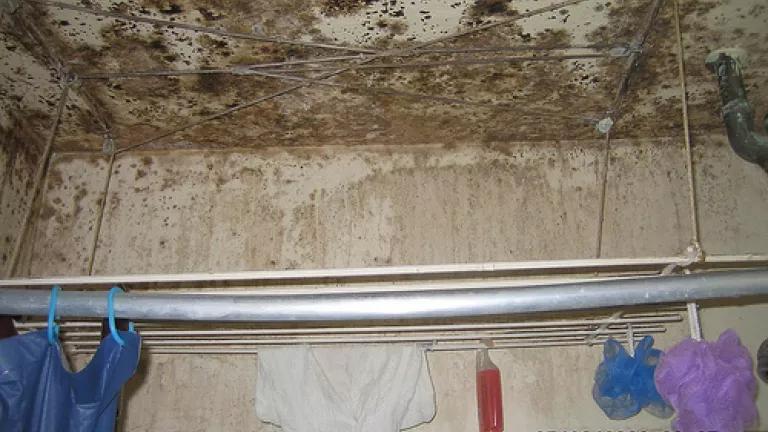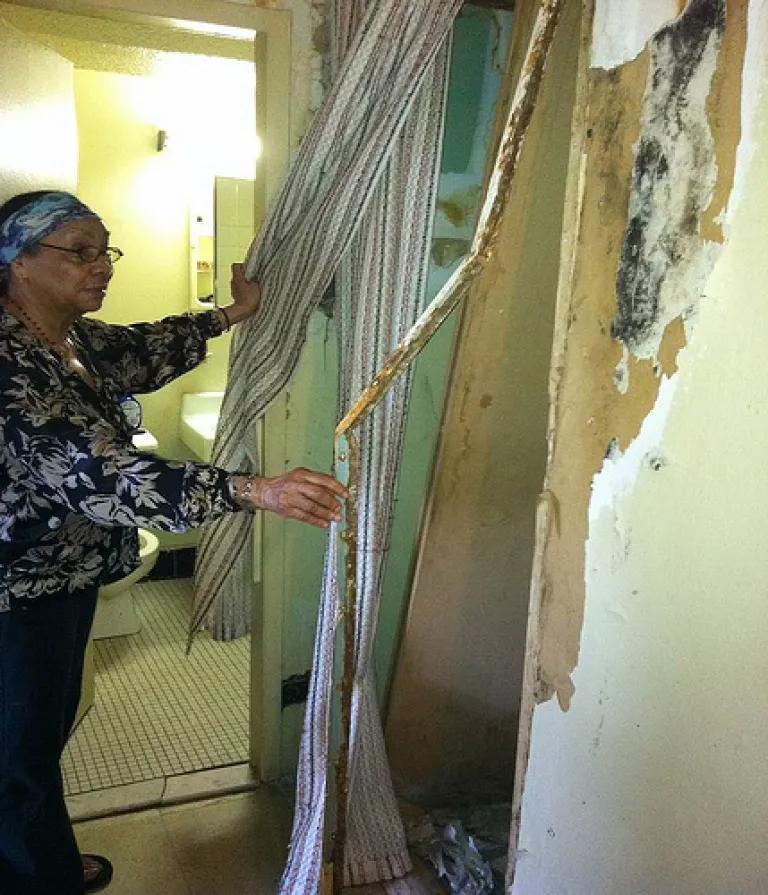
On New Year’s Eve last year, Rossana de la Cuadra wasn’t celebrating. She was in the hospital with her six-year-old daughter, Amanda Santos, who was experiencing yet another severe asthma attack. An inspection of the family’s apartment, in the city-owned Van Dyke building in East New York, Brooklyn, revealed a possible threat to Amanda’s health: heavy mold growth in the bathroom and moisture on the walls, including in Amanda’s bedroom. Excessive mold and moisture is a pervasive problem in New York City public housing; mold and moisture also make the symptoms of asthma, which is epidemic among New York City public housing residents, markedly worse.
A moldy bathroom in the Taft building, East Harlem
In a landmark environmental justice legal settlement announced today, the New York City Housing Authority (NYCHA) has agreed to drastically revise its response to mold and moisture problems in public housing, and to finally address the asthma epidemic that disproportionately affects the city’s 400,000 public housing residents. This is a major and welcome change in city policy. NRDC and the National Law Center for Economic Justice filed the class action lawsuit that led to the settlement, on behalf of public housing residents, individual tenants, as well as the community advocate groups Manhattan Together and South Bronx Churches.
Public housing residents often wait months for a response to a mold complaint, enduring foul odors, respiratory problems, even missing days of work or school due to illness. In the Webster building in the South Bronx, 61-year old Felipa Cruz keeps a garbage pail in her hallway to collect water dripping through a hole in her ceiling in her city-owned apartment. In another South Bronx building, the Melrose, Maribel Baez has endured six years of water seeping through her bathroom ceiling, spurring mold growth. Both women have missed several days of work due to asthma.

Mold in city-owned housing in the Melrose building, in the Bronx.
In the agreement, the city for the first time acknowledged that mold and moisture are a health threat to residents with asthma—and that water is the root cause of mold. The typical response of painting over or washing moldy spots (sometimes years after the problem has been reported) will not be an acceptable remedy. The city agreed to a timeline for responding to mold complaints, with the most simple repairs to be completed within 7 days. The mayor’s office, which deserves credit for embracing a fresh and serious approach to this issue, will fund a pilot project using electronic moisture detectors to locate sources of water within an apartment, helping stop mold before it becomes visible on walls and ceilings.
Addressing the problems underlying mold and moisture complaints, such as leaks, lack of ventilation, and un-insulated pipes, will help protect the health of public housing residents. Residents of city-owned housing have dramatically higher asthma rates than other city residents. One study found that asthma prevalence among children living in New York City public housing is nearly twice as high as children living in other types of housing in the city.
Public housing residents also suffer disproportionately from the effects of climate change. After Hurricane Sandy, many NYCHA buildings were flooded and remained without power long after the rest of the city was up and running. The prolonged wet conditions allowed mold to flourish. As climate change is expected to generate more severe storms and flooding in the years to come, the mold problem in public housing will get worse, putting residents’ health at risk.
Acknowledging for the first time that asthma may be a disability under the law, NYCHA will inform residents that they may be entitled to individual accommodations to protect their health from the debilitating effects of mold and moisture. The settlement also provides for training, supervision, monitoring and data collection to ensure a constantly improving program.
“Home should be a place where you are safe, not a place that hurts you,” says Baez. “My hope is that with these groups, our lawyers, and a federal court all keeping NYCHA and the city accountable, conditions for me and my fellow tenants will begin to improve.”
